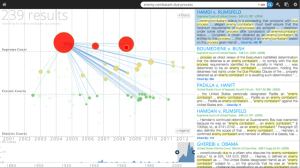Ravel Law: Unraveling Justice Through Big Data
Ravel Law has employed digital tools to brilliantly upset the status quo of a digital-phobic industry.
The word “innovative” does not necessarily come to our minds when describing the legal profession. Court rooms and law firms have long been bastions of tradition and formality, seemingly immune from the increasingly digitalized outside world. Ravel Law, a San Francisco-based startup, is on a mission to disrupt the legal profession. The company has been making strides in the industry and is expected to reshape how law firms operate and how they compete among themselves.
the law. mapped.
Ravel Law was founded by two law school graduates, Daniel Lewis and Nik Reed, who became convinced that there is a better way to conduct legal research. Last year, they raised over $8 million in Series A funding led by NEA and North Bridge Venture Partners. Ravel Law’s business model is built around the concept of streamlined legal search, analytics and data visualization.
This is how the user interface is designed: a list of results appears on one side of the screen and it is accompanied by a cluster map showing the cases as circles of various sizes. The larger the circle, the more important the case. Lines radiate out of the circles, connecting cases based on citations. (See exhibit.)
Exhibit 1
Data Empowers Attorneys
The traditional approach to legal research involves sifting through volumes of case material. Undeniably, it is mainly a manual labor of hordes of newly-minted Associates. According to one of Ravel’s co-founders, lawyers spend roughly 30 percent of their time doing research. This is where Ravel’s value creation is unlocked. Ravel empowers attorneys to benefit from the influx of information and to find value in it.
First, Ravel’s comprehensive database, arguably deeper than any of the existing solutions, gives their users access to a broader library of case law. It provides an opportunity to find that needle in the hay stack precedent that may change the course of the case.
Second, Ravel offers an efficient way of analyzing cases – the visualization helps lawyers quickly understand the landscape for an issue and better filter results based on relevance. This in turn allows them to devote more time to higher value-add activities.
Finally, the most novel and fascinating feature is “Your Judge, Unraveled.” “Good lawyers know the case, great lawyers know the judge” claims the company. Ravel’s algorithm uncovers patterns in how judges rule and what factors might influence their decisions. This is the feature with greatest implication on the industry and likely the most contentious one.
Taking a Piece of a Massive Pie
The legal industry is estimated to be worth $300 billion a year. The size of the opportunity makes it even more surprising how little innovation there has been to-date. However, some of the more forward-looking law firms begin to realize the inevitable change, which makes me believe that they might welcome Ravel’s product. I recently attended, as a guest speaker, an Associate training event at a major law firm. The main message of the day was: how can we incorporate innovation into our practice.
The company is still refining their pricing models but the most attractive approach to value capturing appears to be a subscription-based model with different fee brackets based on the size of a firm. I see a strong opportunity for Ravel to capitalize on their tools. I can imagine Ravel’s system becoming a staple of the legal industry, in the same way as CapitalIQ became an indispensable tool in investment banking.
Industry Transformation
Ravel Law is a digital-era winner. It employs a fresh approach to an industry ripe for a change, while also shifting power dynamics among industry players.
Existing digital legal databases such as WestLaw and LexisNexis are primarily aggregators of legal materials. Ravel takes this digital project much further through data visualization. Ravel’s collection of powerful tools transforms how lawyers prepare for litigation.
To perform a truly thorough legal research today, it requires a large team of lawyers that is only affordable by the wealthiest clients of major law firms. Ravel creates a more leveled playing field, since the kind of data insights that can help a lawyer improve a motion will hopefully become much cheaper and more widely accessible.
I can envision a situation where a boutique law firms will have the horse power to compete head to head with larger players. As a result, major law firms will be forced to find new ways to differentiate themselves and add value, thus spurring further innovation.
Ravel Law has employed digital tools to brilliantly upset the status quo of a digital-phobic industry.

Sources:
www.crunchbase.com/organization/ravel-law
www.techcrunch.com/2015/04/16/who-judges-the-judges/
www.abajournal.com/magazine/article/visual_law_services_are_worth_a_thousand_words–and_big_money




